If there’s one thing most RVers understand, it’s that RV roof leaks are not only possible but very common. RV roofs are prone to leaking. There are a number of reasons for this, the most common of which applies to every single RV on the road IF the roof of the RV has ANY holes, which most do.
Seams, air conditioners, fans, vents, antennas, solar panels, etc. are mounted to RV roofs with components and/or cords running through the roof and into the RV. RV roof leaks are common, insidious, and can cause serious damage if left unattended (or unnoticed until it’s too late).
In today’s post, we’ll discuss the easiest, most reliable ways to PREVENT RV roof leaks (that’s the number one goal!), and how to address them if you’re beyond the prevention stage.
Let’s begin by looking at the main reasons why RV roofs leak in the first place.
Why is My RV Roof Leaking?
There are two main reasons why RV roof leaks occur. The first has to do with the way roof seams and objects on the roof are sealed, and the second has to do with accidental damage.
(1) Improperly Sealed Rooftop Objects or Failed Sealant
This is the most common reason why RV roof leaks begin. And once they’ve begun, you’ve got a potentially serious problem on your hands.
The biggest issue is that your RV roof could be leaking without you even knowing it. RV roof leaks can allow water to seep into the roof without ever alerting you to a problem with a noticeable leak (evidence of water inside, staining of the roof liner, etc).
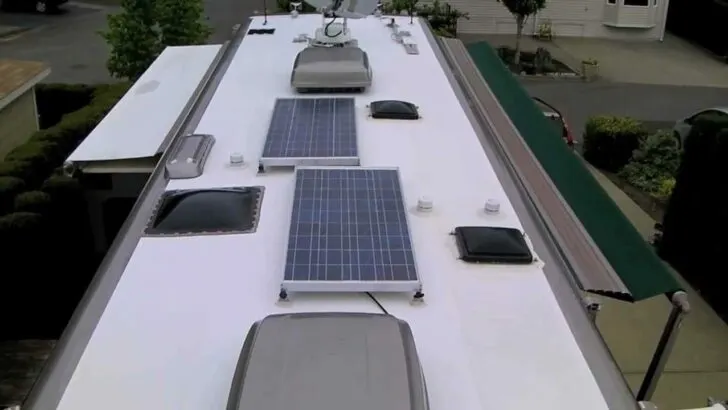
Everything you see on this roof involves multiple holes penetrating the structure. There are many areas of an RV roof that can leak if the sealant is not diligently maintained over time.
This actually happened to friends of ours who bought a used RV. Unbeknownst to them, water had been leaking, undetected, through an unprotected seam for some time. Because the leak occurred slowly over a long period, the damage to the roof was able to spread gradually without becoming evident, since there were no obvious signs of water in the RV’s interior.
That’s right – we said NO obvious leaks into the interior of the RV. None of the things we all look for when thinking about the potential for an RV roof leak. No wet walls or ceiling, and no staining.
What actually tipped our friends off was an increasingly “soft” feeling and a “crunchy” sound when they walked on one particular section of the roof. Until then, no one was the wiser.
But areas of sealant along a rooftop seam of the RV had failed at some point, and water was able to seep into the roof unnoticed. We’ll show you more about this case a little later in the post.
(2) A Puncture in the Roof Membrane
The second most common reason for RV roof leaks can be more obvious, (though not always), and that is a punctured roof.
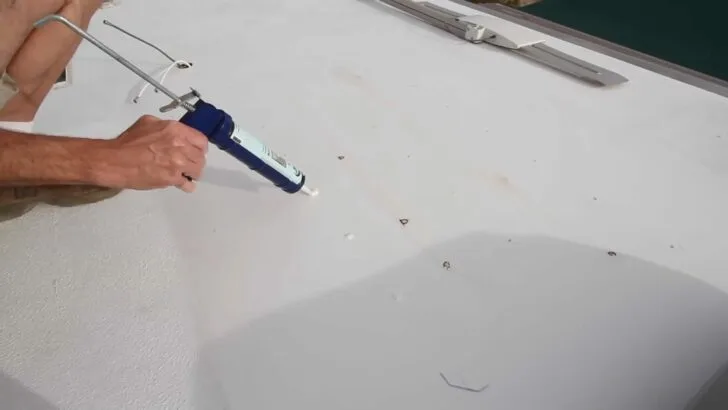
Anywhere there’s a hole in the roof of your RV, it needs to be well sealed, and the sealant needs to be monitored regularly and replaced as necessary.
Tree branches have punctured many RV roofs, though this is more of a problem for roofs made from certain materials (rubber/EPDM/TPO roofs in particular). Low-hanging tree branches can puncture an RV roof as you’re driving or, if you’re parked under trees, branches can fall onto the roof causing damage.
Unless you hear the damage as it occurs, or you take a look at your roof regularly, you might not even realize that your roof has been punctured. That’s why regular inspection of your RV roof including all seams and areas where sealant has been applied is so important. We harp on this often, and with good reason. RV roof leaks can cause unfathomable damage, even rendering an RV useless.
Flat RV roofs that allow water to sit are most prone to extreme water damage, and serious damage can occur in a relatively short span of time.
Let’s take a look at some RV roof construction.
What is an RV Roof Made Of?
There are several answers to this question, though perhaps not as many as you might think.
RV roofs can be made of a variety of materials including rubber, fiberglass, aluminum, wood, and even styrofoam. There are four main types of RV roofs.
- EPDM (Ethylene Propylene Diene Monomer) – a type of “rubber” membrane used for flat roofs. This type of RV roofing is lightweight but can puncture relatively easily, and needs to be repaired quickly to avoid water getting under it and into the layers of the underlying roof structure.
- TPO (Thermoplastic Polyolefin) – another type of “rubber” roof made of bonded polypropylene and ethylene-propylene. This type of RV roofing material varies in thickness and quality, but the rolls of the product are not wide which means that these roofs can have more seams. Seams expand, contract, and can crack, all of which can lead to RV roof leaks that allow water to penetrate the roof structure.
- Fiberglass – reinforced plastic made of a resin of textile fiber and glass. Fiberglass is a more durable material that’s resistant to rust and rot, cracks, and other damage. Strong and lightweight, a fiberglass RV roof is less prone to damage but, if damaged, is very expensive to repair, though it can be repaired in sections.
- Aluminum – constructed using sheets of aluminum roofing, aluminum RV roofs are durable and resistant to penetration from limbs. They far outlive RV roofs made of softer materials. Aluminum roofs are also less vulnerable to damage due to friction from the movement of the RV. However, aluminum has to be adhered using galvanized nails because it doesn’t adhere well with glue. Leaks that occur under aluminum are very stealthy and can remain hidden for years until someone steps on the roof and finds a weak area.
One type of flat RV roof constructed of styrofoam and 5.2mm Luan plywood paneling pressed to form roof panels are known as vacuum-bonded roofs, and the construction, though it initially results in a strong, lightweight RV roof, has presented headaches for some RV owners.
A vacuum-bonded roof has no trusses or any other type of support in addition to the pressed styrofoam/Luan. So, while it’s strong as long as the Luan doesn’t get wet, if a leak occurs, the wood can get wet enough to separate from the styrofoam core. Once the roof begins to sag, rain collects in the dips causing more damage as the area sags even more with the weight of the collected water.
This type of roof can generally only be adequately repaired with a new roof, which is a very costly repair.
The three most common hidden dangers of RV roof leaks involve two threats of serious structural damage to the roof and one that’s an insidious, and potentially dangerous, threat to the health of the RVer.
Danger to Health from Mold and Mildew
The most important consideration has to do with the health of the folks traveling and living in any RV that’s had any significant RV roof leaks. That danger is the result of mold and mildew setting up shop in the RV.
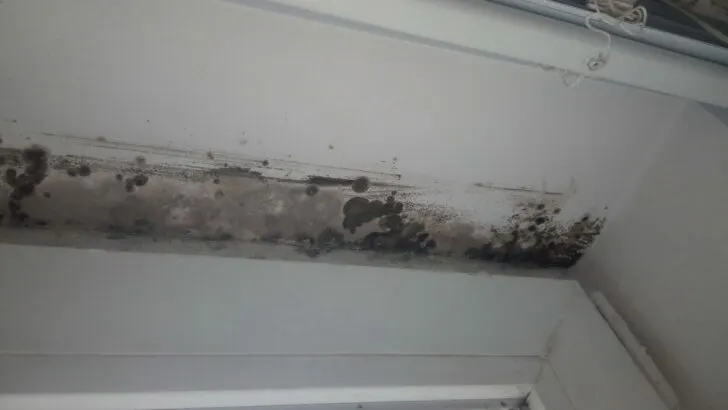
Mold and mildew can occur anywhere there is moisture. Sometimes RV roof leaks seep into areas where we can’t see the leak OR the mold.
Not only can breathing mold and mildew cause numerous respiratory issues for healthy RVers, but people with asthma or allergies to mold and/or mildew can suffer great distress from time spent in a moldy environment.
Mold and mildew can sometimes be smelled or sensed but not seen for a very long time – a silent trouble-maker threatening the health of adults, children, and pets.
Sidewall Delamination
We’ve all seen it either in pictures or up close and personal – bubbles, waves, and blisters that are pronounced enough to notice from the outside or the inside of an RV.
This type of damage is sidewall delamination caused by the failure of the bonding agent when RV roof leaks get through to the styrofoam and wood under an RV’s fiberglass or gel coat exterior. This exterior layer pulls away from the substrate (made of Luan or some other type of lightweight plywood), and the damage spreads from there.
Tiny cracks can also occur from stress, but the intrusion of water is what accelerates the damage as the delamination spreads.
Water Damage to Structure – Wood Rot
This is what happened to the friends we mentioned at the beginning of this post. They bought a used RV that had an undetected leak through an unprotected seam for some time. As the leak went unnoticed, the structure of the roof was damaged, and the damage was able to spread, causing the wood to rot silently but seriously.
Following is a video we made of the damage to the RV owned by our friends. We’ve been around RVs for a long time, and even we were stunned to see the extent of this damage to a well-constructed motorhome.
How Do I Stop My RV From Leaking?
The best way we know to stop your RV roof from leaking is to practice proper preventative roof maintenance. This can be easier said than done, particularly if you purchase a used RV along with a history you know nothing about.
However, the more diligent we are about preventing RV roof leaks, the less we’ll ever need to worry about how to stop an RV from leaking.
In our post entitled “Maintain Your Dicor RV Roof Sealant to Prevent Leaks”, we show you how we prevent RV roof leaks from occurring in our 2005 Newmar Mountain Aire. We’ve been living, working, and traveling full-time in our RV for more than 16 years now, all without a single roof leak.
This method clearly works, and we encourage you to be diligent about checking all of the Dicor and any other sealants on your roof (and any roof seams) on a regular schedule. We check ours a minimum of twice a year.
If you already have an RV roof leak (read “Finding RV Roof Leaks: An Ounce Of Prevention Avoids Damage“), removing the old sealant and replacing it with new is the DIY repair for any minor leaks around holes that have been made in your RV. Any area where the roof has been penetrated for any reason requires your regular attention. Check the sealant for cracks or damage, and replace as necessary.
NOTE: if, when you get on your roof to inspect your sealant, it doesn’t look like Dicor, we recommend contacting your dealer/manufacturer to confirm what product they use. Not all manufacturers use Dicor to seal roof penetrations (according to a comment below from MarkT, even Newmar has changed sealant on the fiberglass roof of the latest model NewAire and uses variations of Sikaflex sealant instead of Dicor), so you want to be sure you replace/repair your sealant with the same material as originally used.
The same is true of seams that are bonded with sealant. As you can see from the dramatic result of a poorly maintained seam in the video embedded above, any seams on RVs should be regularly checked for the integrity of the sealant.
All you need other than a putty knife to assist with the removal of the old Dicor is a tube of Dicor and a caulk gun. That’s it!
- RV ROOFING USE: Lap sealant is sun-ray stabilized to avoid spoiling and discoloration; Plus, it will not stain or discolor any roofing material to...
- COLOR: White hue for stylish and beautiful RV roof
Dicor is also available at just about any camping supply store or RV dealer. Before applying new sealant, just clean the area to be patched with mineral spirits. Just be aware that if you have a rubber roof, it’s OK to clean the Dicor with mineral spirits… just go easy on the quantity, being sure not to soak the rubber.
And finally, some RV roof leaks can be stopped by repairing roof damage with an amazing sealant tape called Eternabond. This tape creates an incredibly strong bond and is very durable, usually lasting for years – decades, even – when applied to appropriate surfaces and under normal circumstances.
This is the 6” wide version (50’), but it’s also available in a 4” wide version in both black and white, on Amazon.
- Ideal for use in sunny environments
- Simple installation only requires some surface preparation before use
Does RV Insurance Cover RV Roof Leaks?
Most RV insurance offers collision, medical, content replacement, comprehensive, and liability coverage.
Many people think the “comprehensive” category would (or should) include damage from RV roof leaks, but in fact, it’s quite possible that your insurance coverage does NOT include damage from leaks.
Our advice: Talk with your insurance agent about this IN ADVANCE OF any damage to your RV. Know clearly what is and is not covered by your RV insurance policy, and ask how to obtain the coverage you want, depending on its affordability.
Where RV roof leaks are concerned, it may depend on the way the damage occurred. For example, insurance companies DENY claims on the damage that occurs from leaks that are considered to be maintenance-related. This would include leaks around caulking joints, old AC gaskets, cracked, uncaulked, or poorly caulked (including old cracked or damaged) skylights and vents, and exposed screws that have not been adequately covered with protective sealant.
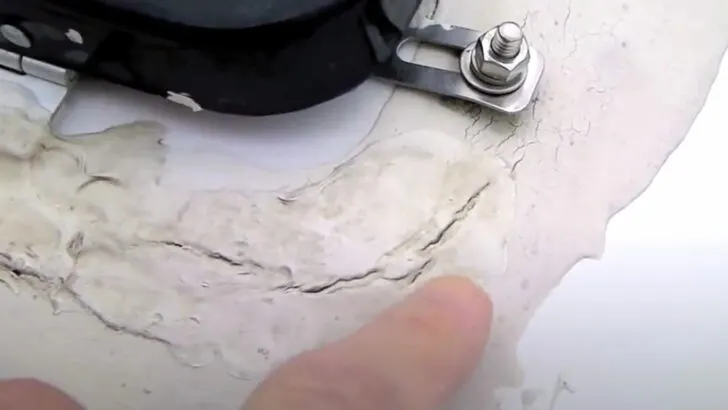
Dicor sealant that is cracked like this from exposure to the sun and other weather needs to be replaced. It’s an easy and worthwhile job. A quick check of the sealant around vents, fans, solar panels, air conditioners, and antennas every 30 days or so keeps our RV roof in great condition, avoiding potentially costly leaks.
This, again, is why we tend to yell from the RV rooftops – MAINTAIN YOUR RV ROOF SEALANTS. Follow our guide to maintain your roof well and regularly to avoid encountering a denied insurance claim once an RV roof leak has already caused damage.
It’s also important to note that insurance only covers damage that your RV roof sustained during the period of YOUR ownership. Damage determined to have occurred during the period of previous ownership is highly likely to be uncovered by your RV insurance policy.
With all of that said, we’ll reiterate that water damage can occur in different ways, and ALL insurance coverage is dependent on your individual policy. Again we encourage you to talk to your insurance agent about your coverage.
Conclusion
RV roof leaks can be real troublemakers. Learning how to prevent them in the first place is your very best defense against potentially significant damage to your RV, and even to your health.
Geek Out with Us Every Week
Join our newsletter to learn about all things RV-related. Every week we offer free tips, tricks, product reviews, and more to our online community of RVers. Whether this is your first time on the road or you’re a seasoned expert, we’d love for you to geek out with us!

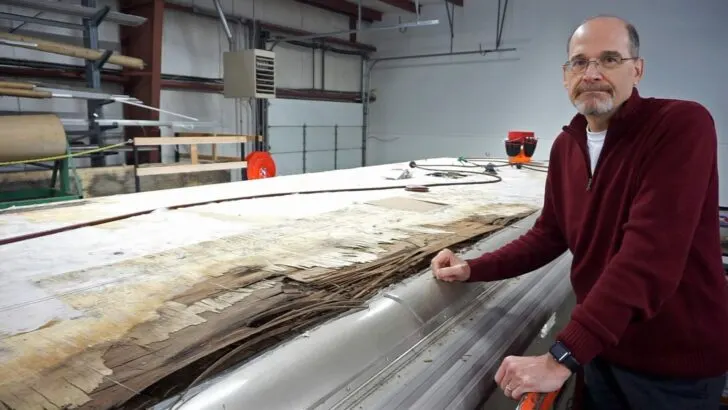


Thomas Baxley
Tuesday 29th of August 2023
Ok I read sign up for our news letter. No link to sign up for the news letter.
TheRVgeeks
Tuesday 29th of August 2023
Hi Thomas! You can sign up here: https://www.thervgeeks.com/subscribe/
MarkT
Saturday 30th of October 2021
Gents, FYI we have a'21 Newmar NewAire and according to the mfg, they don't recommend Dicor but SikaFlex for the fiberglass roof. 715 self-level, 221 not.
TheRVgeeks
Saturday 30th of October 2021
Thanks for the update Mark. We've updated the post accordingly, mentioning your comment. Always great to hear from a fellow Newmar owner.... even one whose rig we're jealous of! LOL
John Ruzich
Saturday 17th of June 2017
I have a 2017 Newmar Baystar Sport and it has a rubber roof by Brite Tek which is installed with termination bar and many small hex head fasteners. It appears sealant was used under the termination bars and is still intact and undisturbed. However, I'm concerned that each of the exposed small fasteners will be potential roof leak point in the long term and that it is hard to determine if a leak is started. Do you think installing Dicor at every one of these fasteners now is a good idea?
Scott Hall Hall
Saturday 17th of June 2017
Hey John, Funny how most folks buy Champagne for their wedding night..the RV geeks buy Dicor to sit on the table to view by candle light. Really now.......that Newmar has the best roof in the business and you need not worry for many years. After the 2 year warranty is up then do as the geek squad offered. Eterna bond tape on a clean roof and you will be fine for years to come. So do not save a buck (or 9) and buy the 99 cent caulk at Home Depot. 10 bucks per tube hurts but cheap stuff is a recipe for failure and major damage.
TheRVgeeks
Saturday 17th of June 2017
Hi John! Without seeing it, we can't say for sure, but your roof is brand new and unlikely to have a built-in design issues that would already require action above and beyond the factory installation... unless and until you can at some point down the line see signs of separation in the termination bars or around the hex head screws. The odds of a brand new rig leaking are slim, so we'd consider taking a wait and see attitude, and doing your usual periodic roof inspections. If you cover up the screws now, you'll be inspecting/touching up that Dicor for the rest of the time you own the rig, when it might be unnecessary. That said, you could also go the other way and take full-bore anti-leak measures, such as covering the entire perimeter with Eternabond. We'd suggest that before you do anything, you consider perusing the Newmar owners forum iRV2.com to see what other owners have experienced. If Brite Tek roofs have been problematic for other owners, we'd tend toward more proactive steps. If not, maybe just keep an eye on it to see how it looks during the first year or two of routine inspections.
Pat Parker
Friday 14th of April 2017
That is why we spend our winters in the desert so hopefully that Does not happen but always have it checked.
TheRVgeeks
Friday 14th of April 2017
You just want to get out of having to get up on the roof. :-P Hope to see you two soon.
Fred Jennings
Friday 14th of April 2017
I am of the camp that if it shows a crack, it needs to be removed and replaced. I'm working on a 13 year old RV. I recap in this video. If you are interested. The roof reseal in on the end of the video. https://www.youtube.com/watch?v=PxMytAUc8wo
Scott Hall Hall
Friday 14th of April 2017
My thought is that the Newmar is big buckaroos. Do it right. My 2007 Pacific Coach works trailer is rolling tupperware. A big plastic $hitbox. So I add Dicor in the cracks. If I had a coach like Newman the Newmar I may want to remove and replace. But....the geek squad is pure maintain. They care for that rig like no other so one little crack could be filled.
TheRVgeeks
Friday 14th of April 2017
Hi Fred. We agree that there are certain circumstances where all of the old sealant should be removed, such as when it's separating from the roof itself, or if the cracking is extreme, with the sealant basically falling apart. But we have never had separation from the roof, or extreme cracking (because we check and touch up regularly). So we would undertake the substantial amount of extra work involved in complete removal only if required, not as standard practice.